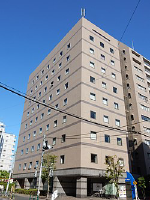Company Analysis Iseki & Co., Ltd.
1. Summary
Advantages
- The stock's return over the last year (156.71%) is higher than the sector average (0%).
Disadvantages
- Price (2390 ¥) is higher than fair price (1726.61 ¥)
- Dividends (3.23%) are below the sector average (7.8%).
- Current debt level 36.62% has increased over 5 years from 35.1%.
- The company's current efficiency (ROE=-4.41%) is lower than the sector average (ROE=9.89%)
Similar companies
2. Share price and performance
2.1. Share price
2.3. Market efficiency
| Iseki & Co., Ltd. | Industrials | Index | |
|---|---|---|---|
| 7 days | 6.4% | -17.4% | 2.1% |
| 90 days | 72.6% | 9.5% | 17.7% |
| 1 year | 156.7% | 0% | 21.9% |
6310 vs Sector: Iseki & Co., Ltd. has outperformed the "Industrials" sector by 156.71% over the past year.
6310 vs Market: Iseki & Co., Ltd. has outperformed the market by 134.78% over the past year.
Slightly volatile price: 6310 is more volatile than the rest of the market on "Tokyo Stock Exchange" over the last 3 months, with typical deviations of about +/- 5-15% per week.
Long period: 6310 with weekly volatility of 3.01% over the past year.
3. Summary of the report
4. Fundamental Analysis
4.1. Stock price and price forecast
Above fair price: The current price (2390 ¥) is higher than the fair price (1726.61 ¥).
Price is higher than fair: The current price (2390 ¥) is 27.8% higher than the fair price.
4.2. P/E
P/E vs Sector: The company's P/E (-13.88) is lower than that of the sector as a whole (122.53).
P/E vs Market: The company's P/E (-13.88) is lower than that of the market as a whole (143.8).
4.3. P/BV
P/BV vs Sector: The company's P/BV (0.2941) is lower than that of the sector as a whole (92.68).
P/BV vs Market: The company's P/BV (0.2941) is lower than that of the market as a whole (127.23).
4.3.1 P/BV Similar companies
4.4. P/S
P/S vs Sector: The company's P/S indicator (0.1254) is lower than that of the sector as a whole (90.1).
P/S vs Market: The company's P/S indicator (0.1254) is lower than that of the market as a whole (125.37).
4.4.1 P/S Similar companies
4.5. EV/Ebitda
EV/Ebitda vs Sector: The company's EV/Ebitda (12.02) is lower than that of the sector as a whole (140.18).
EV/Ebitda vs Market: The company's EV/Ebitda (12.02) is lower than that of the market as a whole (154.8).
5. Profitability
5.1. Profitability and revenue
5.2. Earnings per share - EPS
5.3. Past profitability Net Income
Yield Trend: Negative and has fallen by -9.21% over the last 5 years.
Accelerating profitability: The return for the last year (0%) exceeds the average return for 5 years (-9.21%).
Profitability vs Sector: The return for the last year (0%) is lower than the return for the sector (13.06%).
5.4. ROE
ROE vs Sector: The company's ROE (-4.41%) is lower than that of the sector as a whole (9.89%).
ROE vs Market: The company's ROE (-4.41%) is lower than that of the market as a whole (7.97%).
5.5. ROA
ROA vs Sector: The company's ROA (-1.43%) is lower than that of the sector as a whole (5.43%).
ROA vs Market: The company's ROA (-1.43%) is lower than that of the market as a whole (4.65%).
5.6. ROIC
ROIC vs Sector: The company's ROIC (0%) is lower than that of the sector as a whole (9.6%).
ROIC vs Market: The company's ROIC (0%) is lower than that of the market as a whole (8.88%).
7. Dividends
7.1. Dividend yield vs Market
Low yield: The dividend yield of the company 3.23% is below the average for the sector '7.8%.
7.2. Stability and increase in payments
Dividend stability: The company's dividend yield 3.23% has been steadily paid over the past 7 years, DSI=0.93.
Weak dividend growth: The company's dividend yield 3.23% has been growing weakly or stagnant over the past 5 years. Growth over only 0 years.
7.3. Payout percentage
Dividend Coverage: Current payments from income (2372.41%) are at an uncomfortable level.
Pay for your subscription
More functionality and data for company and portfolio analysis is available by subscription
 MAX Chat
MAX Chat

